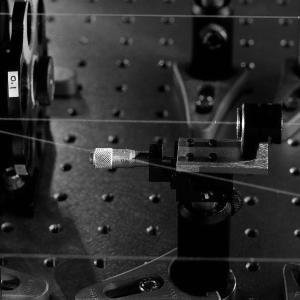Biophysics: The right measure
4 Aug 2022
Study compares two methods for distance measurement in motile proteins.
4 Aug 2022
Study compares two methods for distance measurement in motile proteins.
In the Middle Ages, every city had its own system of easurement. Even today, you can sometimes find iron rods in marketplaces that determined the length measurement valid for the city at that time. In science, however, there is no room for such uncertainties, and no matter what method you use to measure the length of a molecule, for example, the answer should always be the same. Researchers at LMU, the University Hospital Bonn (UKB) and the University of Bonn have now investigated whether this is true for two methods that are very often used to measure distances in protein molecules - for example, to find out how such molecules move.

Laser in the laboratory of Thorben Cordes | © Cordes / LMU
First, the research group of Gregor Hagelueken at the Institute of Structural Biology of the UKB used the PELDOR spectroscopy to study the movement of so-called substrate-binding proteins. These proteins grab their substrate and transport it to a specific location in the cell. To observe this precisely, the researchers attached tiny magnets - the researchers call them "spin labels" - to the proteins and measured distances that are only about a billionth of a meter long. They then transmitted their results to the research group of Prof. Dr. Thorben Cordes at LMU. There, comparative measurements were carried out using so-called FRET spectroscopy. Tiny dye molecules were used instead of spin labels. "Although both methods are used very frequently, no one has yet systematically investigated whether the results are really comparable," say Hagelueken and Cordes.
In most cases the measurement results were comparable. Nevertheless, the researchers encountered inconsistencies in two cases, which is why they continue to recommend measuring with both methods. The scientists also explored the reasons for the differences. “In one case, it turned out that the dye molecules stuck to the protein and thus falsified the measurement", says Bonn post-doctoral researcher Martin Peter. In the second case, the addition of a type of antifreeze, which was necessary because of the measurement temperature of below -220 degrees Celsius, led to unexpected deviations.
LMU/University Bonn
Martin F. Peter, Christian Gebhardt, Rebecca Mächtel, Gabriel G. Moya Muñoz, Janin Glaenzer, Alessandra Narducci, Gavin H. Thomas, Thorben Cordes, Gregor Hagelueken: Cross-validation of distance measurements in proteins by PELDOR/DEER and single-molecule FRET. Nature Communications, 2022.